
Transit Briefs: Metrolinx, SEPTA, Shore Line East, TriMet, Valley Metro
Written by Marybeth Luczak, Executive Editor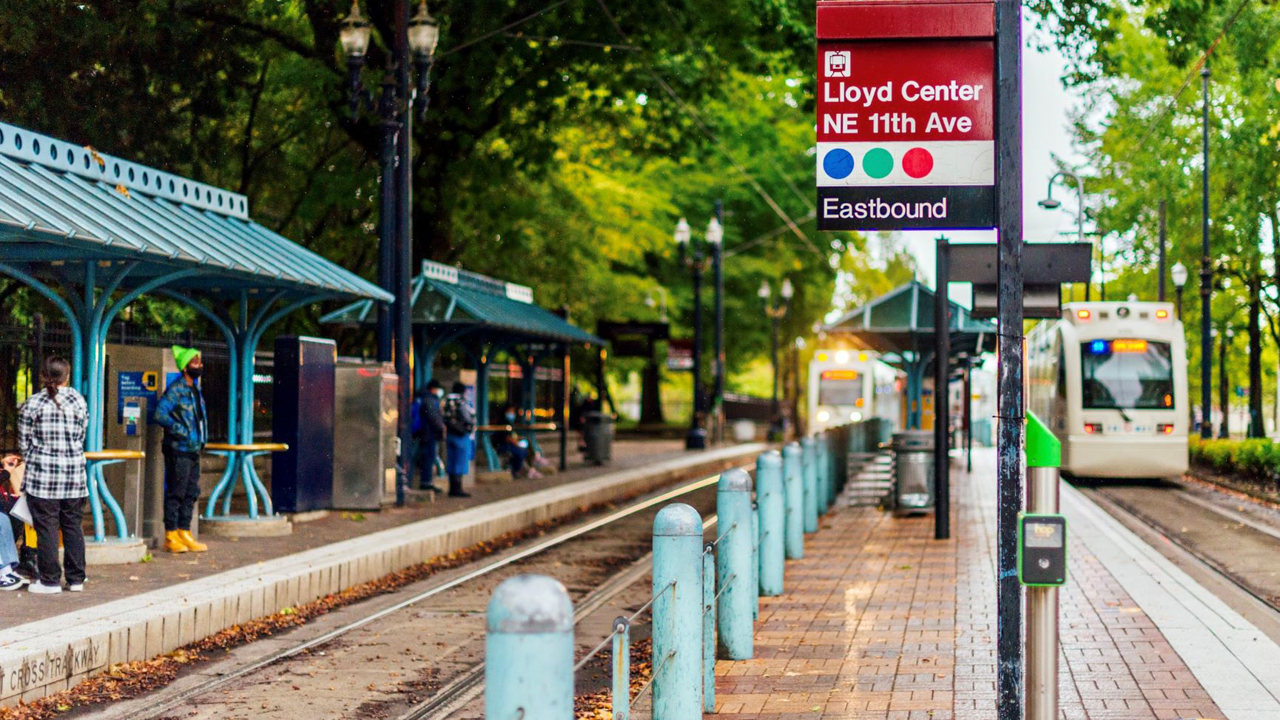
The TriMet Board has approved a $1.93 billion FY 2023 budget.
Metrolinx selected Ricardo Certification to perform safety assessments for the GO Expansion project in Toronto; SEPTA (Southeastern Pennsylvania Transportation Authority) released three options for its Reimagining Regional Rail project; Connecticut’s Shore Line East commuter rail is now operating M8 Electric Multiple Units (EMU); the Board of Directors for Tri-County Metropolitan Transportation District of Oregon (TriMet) approved the FY 2023 budget; and Valley Metro launched its Tempe (Ariz.) Streetcar system.
As Independent Safety Assessor (ISA), Ricardo Certification will assess whether Metrolinx and ONxpress Transportation Partners have developed relevant safety documentation—including system definition, system safety plan and safety case—for the design phase of the GO Expansion rail upgrade project. That documentation must be in full compliance with standards, such as the Canadian Method for Risk Evaluation and Assessment, and EN50126, which is the international standard for the specification and demonstration of Reliability, Availability, Maintainability and Safety for railway applications.
GO Transit’s 25-year rail expansion program in the Greater Toronto Area involves transforming much of GO’s network into a system that will ultimately offer bidirectional all-day service. The program includes new trains, track, signaling, and more than 403 miles (650 kilometers) of electrification.
“This is a complex, multi-faceted program of works, with new rolling stock, a new traction system and extensive infrastructure upgrades, which must be designed to the highest safety standards,” said Richard Gibney, Certification Director for Ricardo Certification. “Using experience of similar projects around the world, we will provide independent assessment to help ensure safety remains at the forefront throughout the key design stages.”
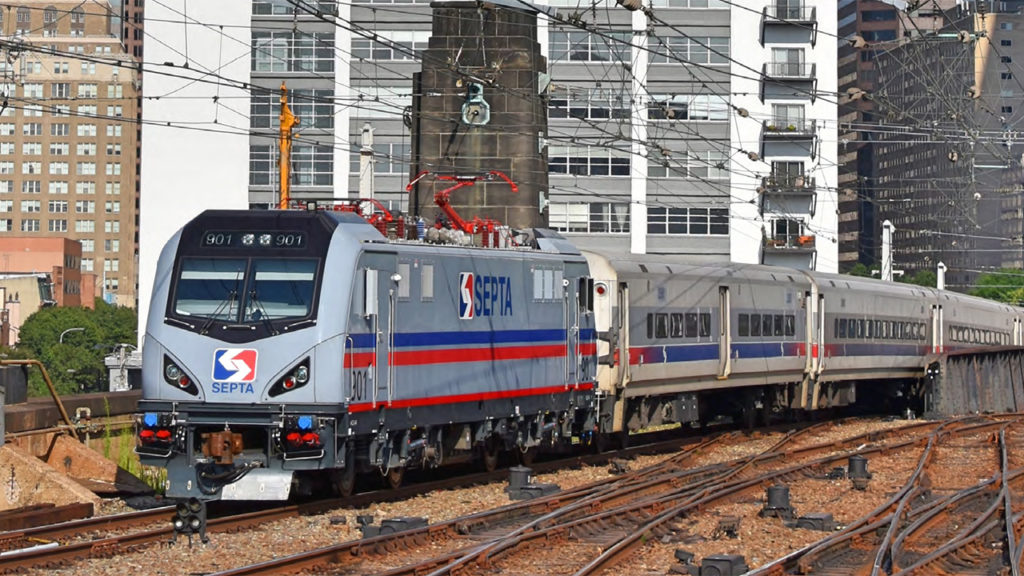
SEPTA in September 2021 embarked on a yearlong, three-phase analysis and public feedback process for “Reimagining Regional Rail.” It is a key initiative of the agency’s strategic plan for fiscal years 2021-26, which “envisions Regional Rail as part of a lifestyle network of frequent, all-day and all-week services that connects people to a range of destinations across the region. Reimagining Regional Rail will create a vision of what that looks like and will identify the infrastructure, equipment, operations and policies needed to get there.”
Pre-pandemic, Regional Rail (see map below) served 132,000 riders daily. “But initial research revealed that even pre-COVID, many riders who would benefit from Regional Rail choose other SEPTA services for a variety of reasons, including higher fares, infrequent service and accessibility,” SEPTA reported.
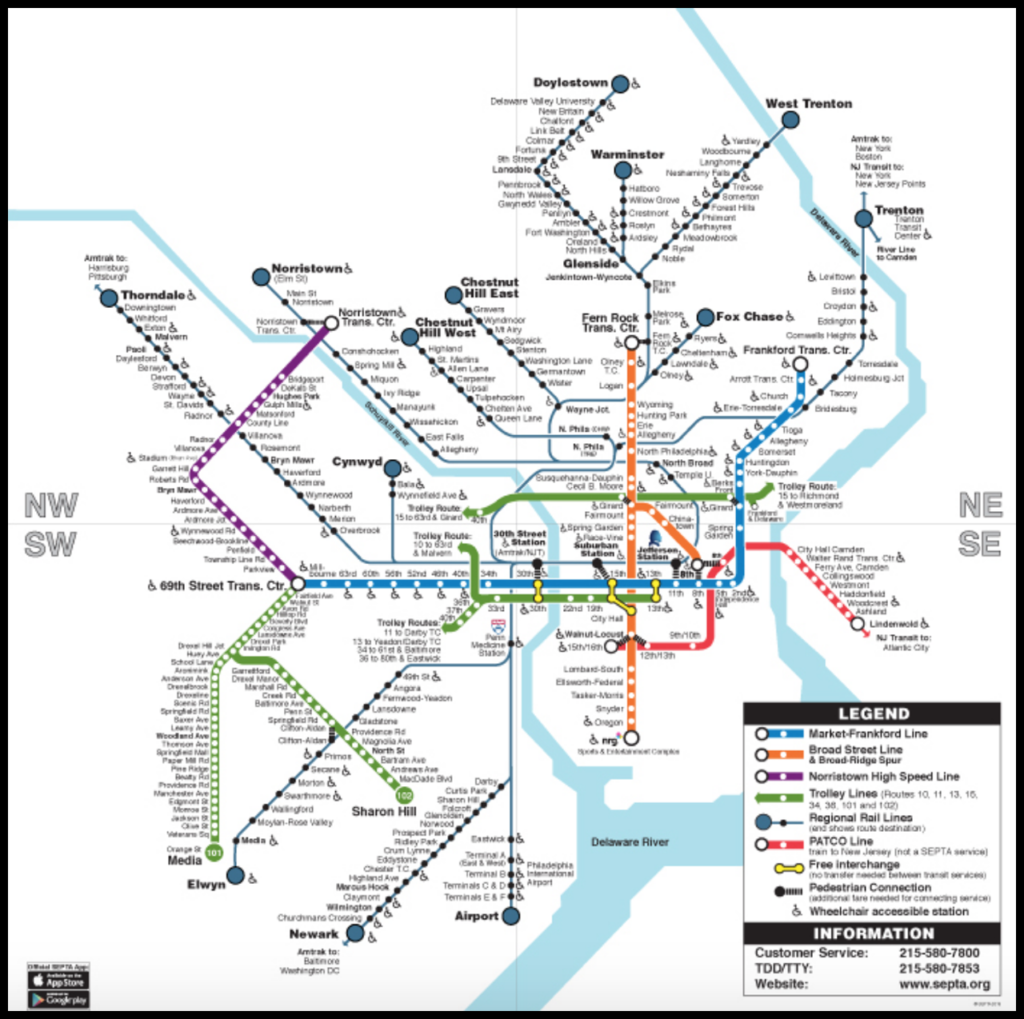
As part of Reimagining Regional Rail Phase 1, SEPTA worked last fall to “better understand what works well, and not so well” with Regional Rail, and set goals. This included gathering feedback from current, past and potential riders as well as operators, staff and other stakeholders. “These conversations will help our region identify a long-term vision, as well as shorter-term improvements to services, schedules and fare polices that make Regional Rail more convenient,” SEPTA reported in September.
As part of Phase 2 in winter 2021 and spring 2022, SEPTA developed three options. The agency reported on May 18 that the options are based on “extensive public feedback, which includes thousands of survey responses, pop-up events at locations across the rail system, a virtual public meeting, and a comprehensive report on the state of the system and similar networks.” The options are:
• “Scenario 1: Focuses on consistent service throughout the network, providing service every 30 minutes.
• “Scenario 2: Focuses on more frequent service (every 15 minutes) in some areas of the system where demand supports it.
• “Scenario 3: Focuses on faster and integrated service across agencies, providing express services across the system all day.”
“This project was a great opportunity to learn why people use the system—and why they don’t,” SEPTA Chief Officer of Planning and Strategic Initiatives Jody Holton said. “We engaged bus riders and non-riders near Regional Rail stations to understand why they chose the bus or other services over Regional Rail.”
“The options released today [May 18] will create a vision for better integration between Regional Rail and other SEPTA modes,” SEPTA General Manager and CEO Leslie S. Richards said.
SEPTA is now collecting feedback on the three scenarios. Phase 3—planned for summer and fall 2022—“will set the vision for the future of the system and develop a plan to implement short-, medium- and long-term solutions later this year,” the agency reported.
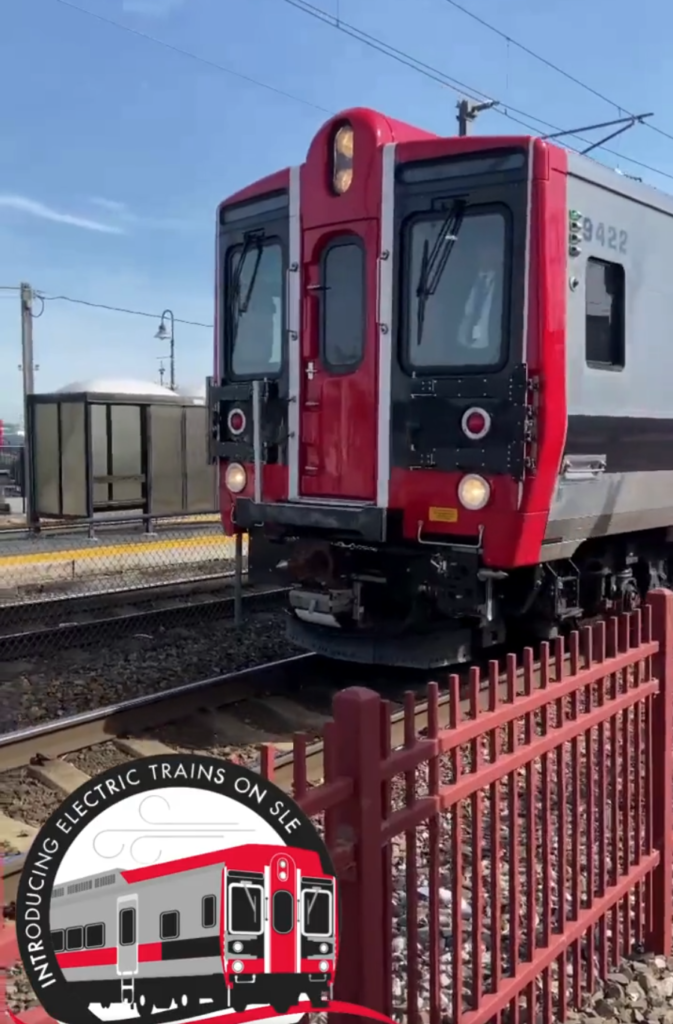
For more than 10 years, Kawasaki-built M8 EMUs have been running on MTA Metro-North Railroad’s New Haven Line in Connecticut and New York. On May 24, they made their debut on Shore Line East, Connecticut Department of Transportation’s commuter rail service between New London and New Haven.
Connecticut Gov. Ned Lamont was joined by CTDOT Commissioner Joe Giulietti, Federal Railroad Administration Railroad Safety Specialist Peter Lapré, MTA Metro-North President/Long Island Rail Road interim President Catherine Rinaldi, Amtrak Assistant Vice President Tom Moritz, and other federal and local elected officials and community partners at a launch ceremony.
“Electric trains on Shore Line East have been talked about for many years, and there were a lot of hurdles to overcome,” Commissioner Giulietti said. “Today’s service changes took the group efforts of CTDOT, Amtrak, Metro-North Railroad and the Federal Rail Administration. Thank you to all who were involved to get us over the finish line. Beyond the direct environmental benefit, these trains are quieter inside and out, offer a more comfortable ride, and have improved amenities I know riders will enjoy. I hope the public will come out and try the Shore Line East service.”
“Metro-North values our partnership with the Connecticut DOT, whose Shore Line East service connects customers with towns along the east coast of Connecticut,” Rinaldi said. “These M8 cars will improve the customer experience by providing faster, more reliable service, which should encourage more people to leave their cars at home and take the train.”
The M8s, which replace older diesel-powered trainsets, offer such rider amenities as electrical outlets at each seat, brighter interior spaces, updated restrooms, higher-back seats, and improved luggage racks.
Railway industrial designer Cesar Vergara, Principal of Vergarastudio, worked on the M8 design. He recently discussed the car interiors in Railway Age: “Some of the mainstream innovations in these vehicles, such as armrests shaped smooth with no cavities or sharp edges, are not only more comfortable and ergonomic, but also afford the cleaning crew ease in wiping on all sides,” he wrote. “The gently curved center ceiling panel, baggage rack and coves are also easier for the maintenance crew to wipe clean. These innovations, intended for ease of cleaning, result in a more ample interior volume for passengers and crew. These features are surprisingly appropriate for a more thorough cleaning during the pandemic. … In the M8, I designed the vestibules, clearly marked by their yellow color flooring, to closely match the tactile yellow of the platform edge. This was not a requirement, but rather a design done in the spirit of the ADA for the visually impaired. The result was a clearer definition of the vestibule as well, and a very well-received aesthetic.”
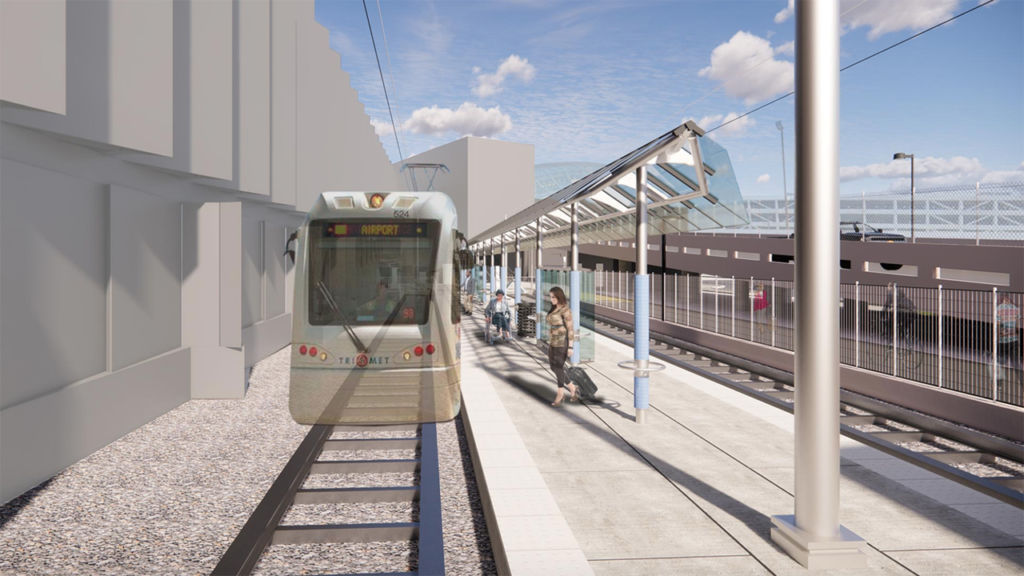
TriMet’s $1.93 billion budget includes $748.9 million for operations and $304.1 million for capital improvements. For the 10th straight year, it does not include a base fare increase.
During the upcoming year, TriMet reported it will continue work on the “A Better Red” MAX Red Line Extension and Reliability Improvements Project, which will extend the Red Line 10 stations into Hillsboro and add sections of track in northeast Portland to keep trains throughout the MAX system moving and reduce delays; replace TriMet’s original light rail vehicle fleet with new MAX trains, which will begin arriving later this year; increase capacity at the MAX Orange Line’s SE Park Ave Parking Garage; and complete renovating the Powell Operating Facility to support its growing fleet of electric buses.
Resources that support the budget include $78.8 million in operating revenue, $470.1 million in tax revenues, and $164.5 million in federal funding. TriMet has been awarded federal funding from recent relief packages including: $184.9 million from the Coronavirus Aid, Relief and Economic Security (CARES) Act; $195.4 million from Coronavirus Response and Relief Supplemental Appropriations Act (CRRSAA); and $289.1 million from American Rescue Plan (ARP) Act.
TriMet reported that it used CARES Act funds through fiscal years 2020 and 2021 and is slated to draw down CRRSAA funds by June 30, the end of the current fiscal year. ARP funding is projected to last through early 2027, according to the agency.
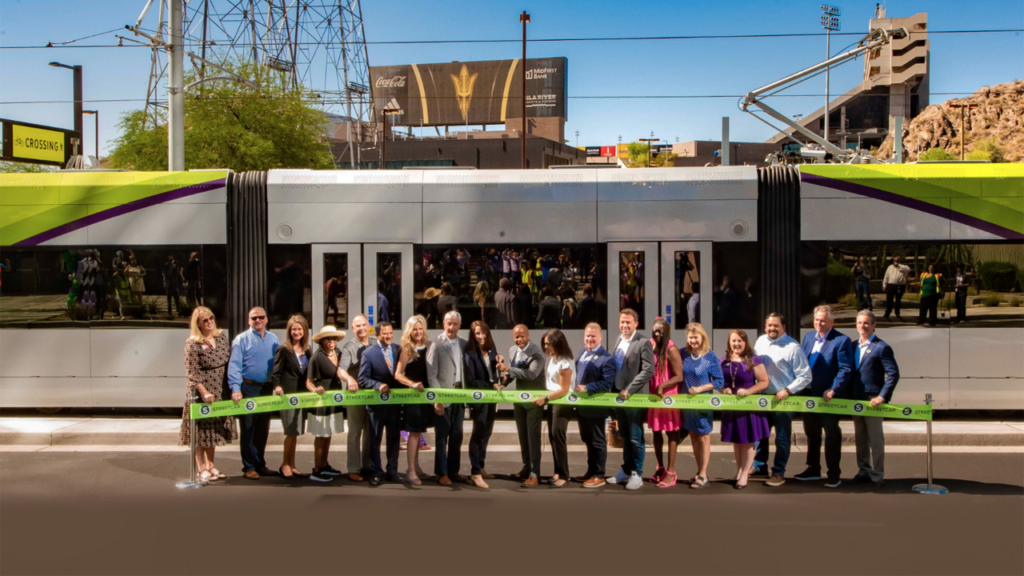
Valley Metro’s Tempe Streetcar system launched May 20 with a ribbon-cutting ceremony featuring local leaders and elected officials. Four of the six Brookville Equipment Corp. hybrid vehicles are now running along the three-mile, 14-stop route, whose construction got under way in 2018. The new streetcar system serves Tempe destinations such as Tempe Beach Park, Marina Heights, Gammage Auditorium and Arizona State University sports facilities (see map below), and offers links to existing light rail service.
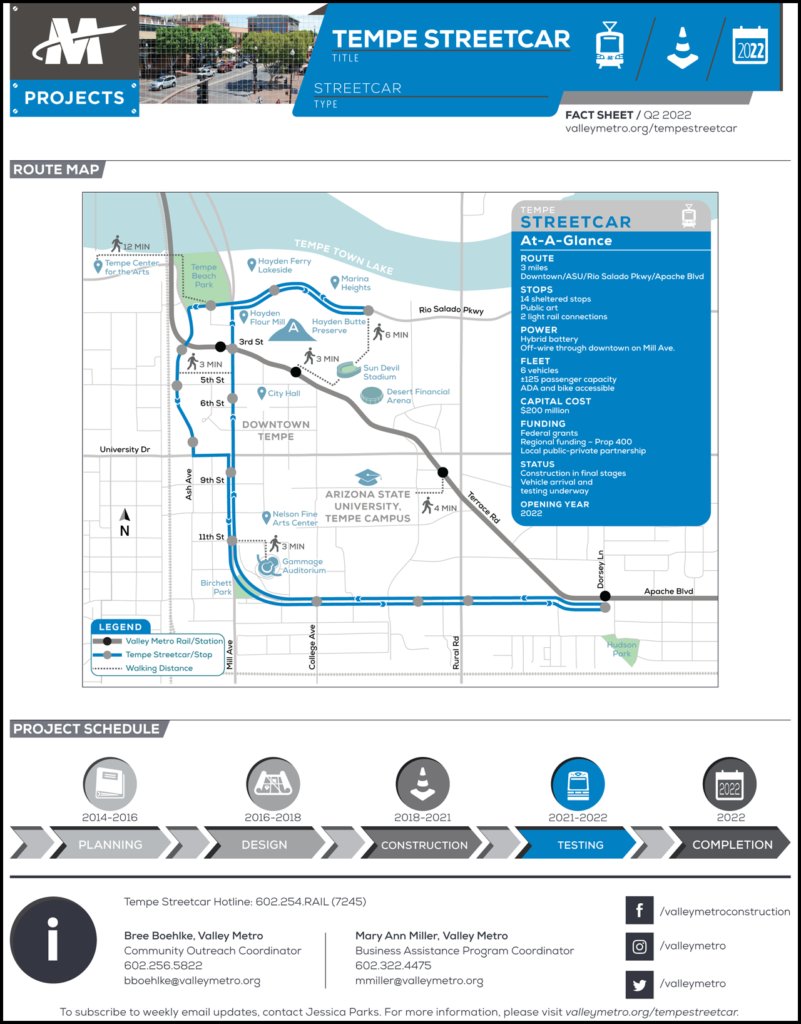
The hybrid vehicles use a lithium-ion battery OESS (onboard energy storage system) to operate along Mill Avenue in downtown Tempe and at gateway intersections where there is not an overhead catenary system (OCS). The streetcars’ batteries stay charged with OCS traction power. Valley Metro reported that service is approximately every 20 minutes, “with frequency improving later this year with the addition of the final two streetcar vehicles.”
The Federal Transit Administration (FTA) awarded a $75 million Capital Investment Grant to Valley Metro in September 2019 for the approximately $200 million project, and another $17.4 million in June 2021 under the American Rescue Plan (ARP). The project was also supported by $112 million from regional Prop 400 funds and $13 million from a public/private partnership including the city of Tempe, Arizona State University, and more than a dozen major employers and property owners along the route.
“Streetcar adds another sustainable option for transit riders to move around the Valley and enhances our comprehensive, regional transit network,” said Valley Metro CEO Jessica Mefford-Miller, who joined the agency in April. “It’s also the start of a streetcar system that we hope to extend into Mesa in the coming years.”
“Modern streetcar would absolutely not exist without the partnership of several creative and bold leaders, including Valley Metro, the city of Tempe and the local business community,” said John Graham, President and CEO of Sunbelt Holdings, and one of the more than 12 business members to raise $13 million for the streetcar project. “We rallied together to help fund this first-of-its-kind public-private partnership because we recognize streetcar’s benefit to downtown Tempe and to us as employers and developers along this and future corridors.”


